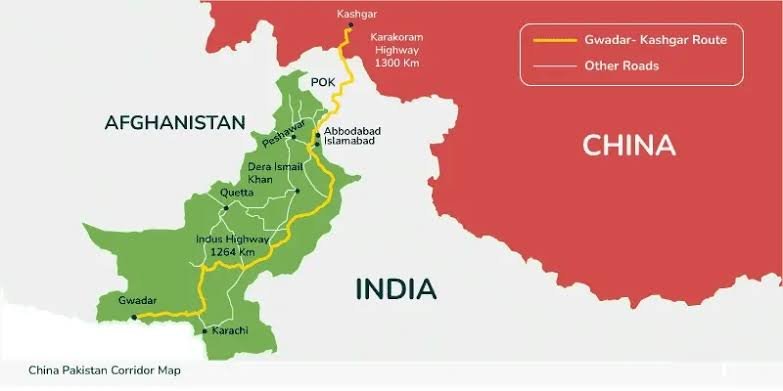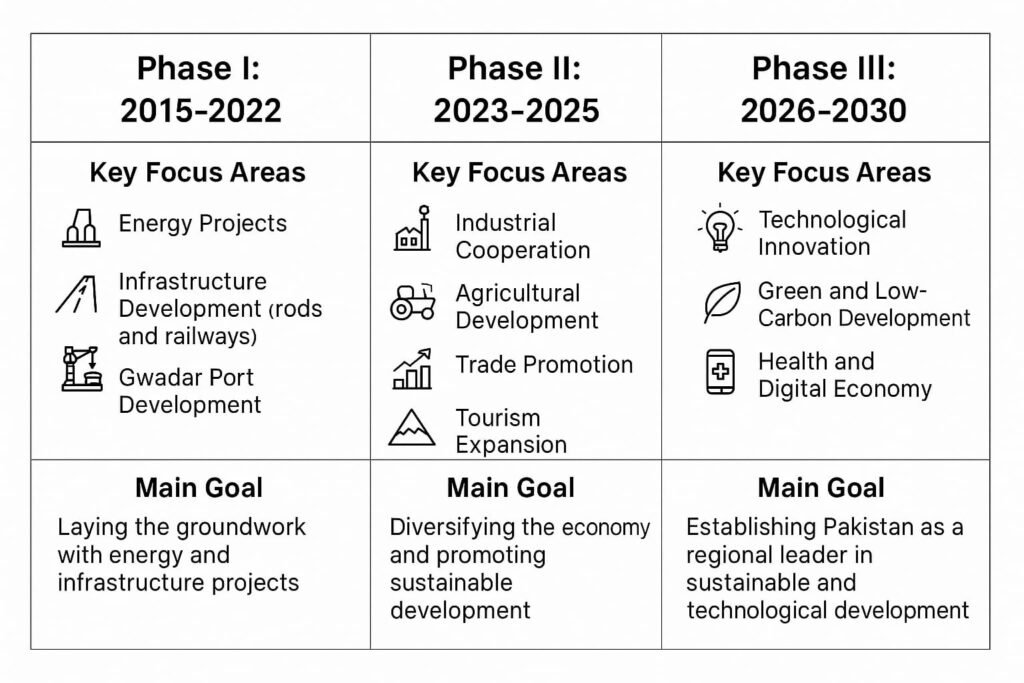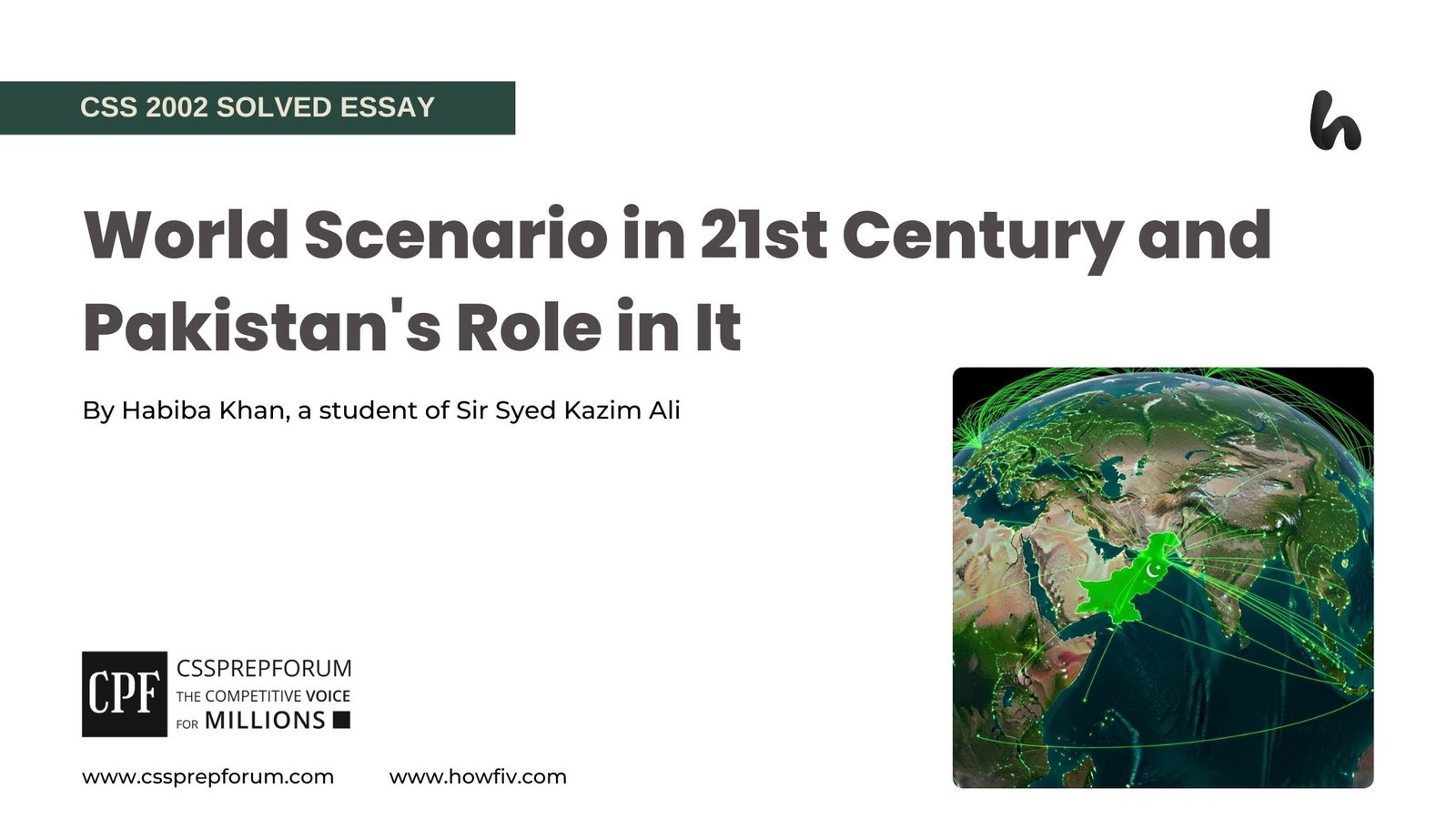CSS & PMS Pakistan Affairs | CPEC, Green Corridor, and the Natural Environment of Pakistan
The following question of CSS Pakistan Affairs is solved by Pryanka Lohana under the supervision of Howfiv’s Pakistan Affairs and Current Affairs Coaches: Miss Iqra Ali and Sir Ammar Hashmir. She learnt how to attempt 20 marks question and essay writing from Sir Syed Kazim Ali, Pakistan’s best CSS and PMS English essay and precis teacher with the highest success rate of his students. This solved question is attempted on the pattern taught by Sir to his students, scoring the highest marks in compulsory and optional subjects for years.

Outline
1- Introduction
2- A Historical Perspective on the China-Pakistan Economic Corridor (CPEC)
3- Implications of CPEC on the natural environment of Pakistan
- ✓ Coal-fired power plants contributing increased carbon footprint
- ✓Infrastructure development leading to large-scale deforestation and habitat loss
- ✓ Vehicular Traffic Deteriorating Air Quality
- ✓Unsustainable development and industrialization
- ✓ Rising risk of natural catastrophe’s
4- The role of green corridor in saving the country’s environmental Future
- ✓Shift from coal-based to renewable energy sources
- ✓Development of Green Infrastructure
- ✓Promotion of Electric Vehicles to Cut Transport Emissions
- ✓Adoption of Sustainable and Eco-Friendly Practices
- ✓Strengthening Disaster and climate Resilience
5- Conclusion

Answer to the Question
Introduction
The China-Pakistan Economic Corridor (CPEC), a flagship project under China’s Belt and Road Initiative (BRI), is a transformative initiative that promises to reshape Pakistan’s economic landscape. The ambitious project reflects the deep strategic partnership between China and Pakistan, involving 62 billion dollar investments in energy, transport, and infrastructure. However, CPEC also poses multifaceted implications for the natural environment of Pakistan, including an increased carbon footprint due to coal-fired power plants and infrastructure development leads to large-scale deforestation. Exacerbating these issues, vehicular traffic and industrial effluents have further deteriorated air quality. Nevertheless, the recent emphasis on the Green Corridor initiative within CPEC can save Pakistan’s environmental future by promoting sustainable development. This includes transitioning from fossil fuels to renewable energy sources, developing green infrastructure, promoting electric vehicles to reduce emissions, and adopting sustainable and eco-friendly practices. Ultimately, the long-term success of CPEC depends on its ability to balance economic growth with environmental protection.

A Historical Perspective on the China-Pakistan Economic Corridor (CPEC)
The China-Pakistan Economic Corridor (CPEC), launched in 2015 as a part of China’s Belt and Road Initiative (BRI), is a landmark initiative that aims to enhance regional connectivity and economic cooperation. Rooted in decades of strategic partnership, the corridor envisions linking Gwadar Port in southwestern Pakistan to China’s Xinjiang region through a network of highways, railways, pipelines, and industrial zones. The ambitious project has transformed Pakistan’s economic landscape, creating new opportunities for growth and development. CPEC is structured into three distinct phases, each focusing on specific projects to ensure comprehensive and sustainable development.

Implications of CPEC on the natural environment of Pakistan
CPEC, a massive infrastructure project, has potential to cause implications on the natural environment of the country. Some of the detrimental implications are as follows,
- Coal-fired power plants contributing carbon footprint
To begin with, the significant amount of CPEC’s investment has been allocated to coal-fired power plants in Thar, Sahiwal, and Gawadar. Although these plants intended to navigate energy crisis, they are major contributor of carbon footprint, impacting natural environment of the country. According to the Centre for Research on Energy and Clean Air (CREA), coal power plants under CPEC emit around 36.5 million tons of CO₂ annually. This showcases that these plants emit massive amounts of CO2 and other particulate matter, which exacerbate global warming. Hence, the project’s high reliance on coal-fired power plants contributes heavily to the country’s carbon footprint.
- Infrastructure development leading to large-scale deforestation and habitat loss
Stepping ahead, the development of road and rail networks under CPEC have led to widespread deforestation and habitat loss. It is one of the major environmental concern as loss of tree cover undermines the natural resilience against climate-induced disruptions. In 2017 alone, over 54000 trees were cut down in districts like Abbottabad and Nowshera for construction of roads. This extensive cutting down of trees not only jeopardizes county’s ability to absorb CO2 but also forces ressetlement of the local population. Simply put, the large-scale deforestation and habitat loss under infrastructure development severely impact the natural environment of the country.
- Vehicular Traffic deteriorating air quality
Additionally, one of the major concerns linked with CPEC is increased vehicular traffic, including heavy cargo trucks. As road and rail networks are constructed, the highways and motorways are expected to accomodate vehicles, emitting tons of CO2 that have detrimental effects on air quality. For instance, the smog in the country, especially in urban centers like Lahore, Karachi, and Islamabad, was largely due to emissions from vehicles, worsening air pollution and impacting respiratory health. Consequently, the more vehicles there are, the more emissions there will be. In a nutshell, the increase in vehicular traffic due to CPEC led to profound impacts on environment, deteriorating air quality.
“The transportation sector is one of the largest sources of air pollution, contributing to poor air quality and adverse help affects. “
Environmental Protection Agency (EPA)
- Unsustainable development and industrialization impacting natural environment
Stepping ahead, CPEC is envisioned to develop Special Economic Zones (SEZs); however, the project is being castigated for encouraging unsustainable development and industrialization. Although its early phases aim to navigate energy crisis and boost economic growth, the development of industrial and economic zones ignore the severe effects of industrial effluents that degrade environment, undermining environmental sustainability. As Paul Polman aptly puts it, “The pursuit of economic growth without consideration for environmental sustainability is a recipe for disaster.” Thus, unsustainable development and industrialization under CPEC jeopardize the country’s natural environment.
- Rising risk of natural disasters
Last but not least, CPEC’s infrastructure projects may alter the natural drainage systems that increases the risk of natural disasters like flooding, landslides, and earthquakes. The projects in hilly areas, such as Gilgit-Baltistan and Khyber Pakhtunkhwa can trigger landslides, mudslides, the inadequate natural water flows, and untimely rainfalls. Moreover, the increasing urbanization along CPEC routes further intensifies flood risks, particularly in southern Punjab and Sindh. Hence, the infrastructure development under the CPEC increases the vulnerability of natural disasters.
The role of green corridor in saving the country’s environmental Future
In the domain of Pakistan-China collaboration, particularly within the second and third phases, various foundational principles can guide this partnership towards its green potential. Some are given below:
- Shift from coal-based to renewable energy resources
First and foremost role of green corridor in saving the country’s environmental future is the transition from fossil fuels to renewable energy sources, such as solar, wind, and hydro. Apparently, Quaid-e-Azam Solar Park in Bahwalpur is one of the largest solar project in Asia, which spans over 6,500 acres and has a capacity of 1,000 MW, showcasing the country’s commitment to renewable energy sources. This is the most crucial step towards a greener economy that not only fulfils Pakistan’s growing energy demands but also reduces overall carbon footprint, assisting to combat environmental degradation. In this way, green corridor can save the country’s environmental future.
- Development of Green Infrastructure
Furthermore, development of green infrastructure planned under the CPEC is designed to counter environmental impacts. Matiari to Lahore Transmission Line, spanning over 878 km and delivering clean electricity produced from renewable resources to 10 million homes, is a glaring example. Notably, this transmission line is even operational during severe flood seasons, demonstrating its climate resilience. Hence, the development of green infrastructure not only reduces the county’s dependence on fossil fuels for energy production but also ensures environmental sustainability and climate change preparedness.
- Electrical vehicle manufacturing to reduce emissions
Moreover, green corridor encourages manufacturing of electric vehicles to save the natural environment as the vehicular traffic is the major contributor to air pollution. In fact, the adoption of electric vehicles significantly reduces dependency on fossil fuels and lowers urban pollution. In addition, Pakistan’s admirable partnership with Chinese companies like Build Your Dreams (BYD) to establish electric vehicle manufacturing plants. These plants focus on producing electric buses and cars for public and private use. Nevertheless, the adoption of electric vehicles considerably transforms the old transport sector into a modern and efficient system. Thus, green corridor saves the country’s environment by promoting electric vehicles.
- Adoption of Sustainable and Eco-Friendly Practices
Moving forward, the adoption of sustainable and eco-friendly practices is one of the pivotal role of green corridor to save the country’s natural environment. By prioritizing sustainable development, the corridor can improve urban planning and reduce environmental degradation. Remarkably, the implementation of the Gwadar Smart Environment Sanitation System, the key initiative under CPEC, has introduced sustainable waste management, modern sewage solutions, dumping and recycling techniques in Gawadar, aiming to make it a model green city. To sum up, implementing eco-friendly practices supports long-term environmental sustainability.
“Sustainable development is the pathway to the future we want for all”
Ban Ki-moon
- Strengthening Disaster preparedness and climate Resilience
Lastly, green corridor plays an indispensable role in strengthening disaster preparedness and climate resilience, thus preserving the natural environment. Although Pakistan is one of the countries highly vulnerable to natural disasters due to climate-induced changes such as floods, droughts, and heatwaves, green initiatives enhance the country’s capacity to prepare for natural disasters and strengthen climate resilience. The restoration of wetlands in flood-prone areas of Sindh and southern Punjab to manage overflow during the moonsoon season is a notable example. Moreover, these wetlands serve as carbon sinks and flood buffer, mitigating the environmental challenges. Simply put, the country has strengthened its climate resilience to withstand natural disasters.
Conclusion
In a powerful diagnosis, the China-Pakistan Economic Corridor (CPEC), a multi-billion-dollar project under China’s Belt and Road Initiative (BRI), aims to enhance regional connectivity and economic growth. While its primary focus was addressing the country’s chronic energy crisis and infrastructure development, CPEC has had detrimental environmental implications, including increased carbon footprint, deteriorated air quality, unsustainable development, deforestation and habitat loss. However, the green corridor initiative, particularly in CPEC’s second and third phases, can mitigate these environmental concerns by transitioning to renewable energy sources, developing green infrastructure, promoting electric vehicles to reduce emissions, and adopting sustainable and eco-friendly practices. Hence, it is the crucial initiative that fulfils Pakistan’s growing energy demands while reducing its overall carbon footprint, paving the way for a greener economy.

CSS Solved Past Papers’ Essays
Looking for the last ten years of CSS and PMS Solved Essays and want to know how Sir Kazim’s students write and score the highest marks in the essays’ papers? Then, click on the CSS Solved Essays to start reading them.
CSS Solved Essays
CSS Solved Islamiyat Past Papers
Want to read the last ten years’ Islamiyat Solved Past Papers to learn how to attempt them and to score high? Let’s click on the link below to read them all freely. All past papers have been solved by Pakistan’s top CSS Islamiyat coaches having the highest score of their students.
CSS Solved Islamiyat
CSS Solved General Science & Ability Past Papers
Want to read the last ten years’ General Science & Ability Solved Past Papers to learn how to attempt them and to score high? Let’s click on the link below to read them all freely. All past papers have been solved by Pakistan’s top CSS GSA coachez having the highest score of their students.
CSS Solved General Science & Ability
CSS Solved Pakistan Affairs Past Papers
Want to read the last fifteen years’ Pakistan Affairs Solved Past Papers to learn how to attempt them and to score high? Let’s click on the link below to read them all freely. All past papers have been solved by Pakistan’s top CSS Pakistan Affairs coaches having the highest score of their students.
CSS Solved Pakistan Affairs
CSS Solved Current Affairs Past Papers
Want to read the last fifteen years’ Current Affairs Solved Past Papers to learn how to attempt them and to score high? Let’s click on the link below to read them all freely. All past papers have been solved by Pakistan’s top CSS Current Affairs coaches having the highest score of their students.
CSS Solved Current Affairs












